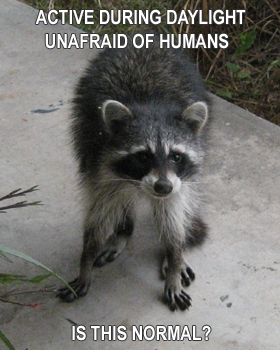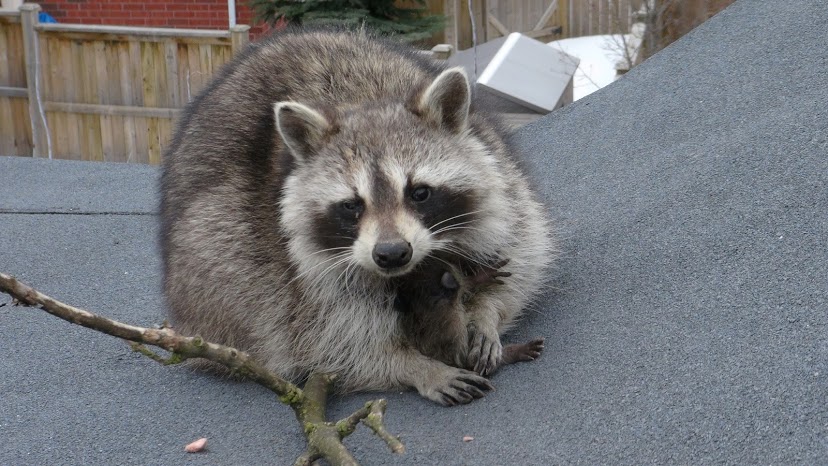What to Do If You See a Raccoon Out During the Day
If you see a raccoon out during the day, stay calm and keep your distance. Contact local wildlife authorities for guidance.
Raccoons are typically nocturnal animals, so spotting one during the day can be surprising. While daytime activity doesn't always indicate illness, it could mean the raccoon is searching for food or has been disturbed. It's important to approach the situation with caution.
Raccoons can carry diseases such as rabies, which pose risks to humans and pets. Observing from a safe distance ensures your safety and the raccoon's well-being. Consulting local wildlife experts can provide the best course of action. They can assess the situation and offer proper guidance. Ensuring you handle the encounter responsibly helps protect both you and the animal.
Initial Assessment
Seeing a raccoon out during the day can be unusual. Typically, raccoons are nocturnal creatures. This initial assessment will help you understand what to do next.
Observe From A Distance
Firstly, maintain a safe distance from the raccoon. Use binoculars if available to observe it better. This ensures you avoid any potential risk. Raccoons can carry diseases such as rabies.
Watch the raccoon's behavior closely. Is it acting normally or erratically? Normal activities include foraging for food, grooming, or exploring. Erratic behavior might include stumbling, aggression, or disorientation.
Look For Signs Of Injury
Check if the raccoon shows any visible injuries. Look for limping, bleeding, or any signs of distress. Injured raccoons may act more defensively.
Use a checklist for signs of injury:
-
Bleeding wounds
-
Visible cuts or bruises
-
Limping or difficulty walking
-
Unusual vocalizations
If you notice any injuries, contact local wildlife authorities. Do not attempt to handle the raccoon yourself.

Credit: humaneraccoonremoval.org
Safety Precautions
Spotting a raccoon during the day can be surprising. Raccoons are usually nocturnal. It's important to follow some safety precautions. This ensures both your safety and the raccoon's well-being.
Keep Pets Indoors
Keep your pets indoors if you see a raccoon. Raccoons can carry diseases. Your pets are safer inside. This includes dogs, cats, and other small animals.
If your pet must go outside, supervise them. Use a leash for dogs. Make sure your yard is secure. Check fences and gates.
Avoid Direct Contact
Avoid direct contact with the raccoon. Raccoons can become aggressive. They may bite or scratch. Do not try to feed or pet the raccoon.
Use a long object to guide the raccoon away if needed. Call animal control for help. They are trained to handle wild animals safely.
|
Do's |
Don'ts |
|---|---|
|
Keep pets indoors |
Try to feed the raccoon |
|
Supervise pets outside |
Attempt to pet the raccoon |
|
Call animal control |
Get too close |
Identifying Rabies Symptoms
If you see a raccoon out during the day, it might have rabies. Knowing the symptoms can help keep you and your pets safe. Look for signs in their behavior and appearance.
Unusual Behavior
Raccoons with rabies often act strangely. They might seem unusually friendly or aggressive. Healthy raccoons are shy and avoid humans. Rabid raccoons may approach people or pets. They might also wander aimlessly or appear disoriented.
-
Unusual friendliness or aggression
-
Approaching humans or pets
-
Wandering aimlessly
-
Disorientation
Physical Signs
Rabies also causes physical changes in raccoons. They may drool or foam at the mouth. Look for signs of paralysis, especially in the legs. Rabid raccoons often have trouble walking or standing. Another sign is seizures.
|
Symptom |
Description |
|---|---|
|
Drooling or foaming |
Excessive saliva around the mouth |
|
Paralysis |
Difficulty moving legs |
|
Trouble walking |
Staggering or falling |
|
Seizures |
Involuntary shaking |
If you notice these signs, keep your distance. Contact animal control immediately for assistance.
Contacting Authorities
Spotting a raccoon during the day can be alarming. These nocturnal creatures usually avoid daylight. If you see one, it might need help. Contacting authorities ensures the raccoon gets the care it needs. Here's how to proceed:
Animal Control
Animal Control departments handle wildlife issues in urban areas. They have the tools and knowledge to safely manage raccoons. Follow these steps to contact Animal Control:
-
Find the local Animal Control number.
-
Call and describe the raccoon's behavior and location.
-
Follow their instructions carefully.
Animal Control officers can determine if the raccoon is sick or injured. They will take appropriate actions to ensure public safety and the animal's well-being.
Wildlife Rescue
If Animal Control is unavailable, consider reaching out to a Wildlife Rescue organization. These groups specialize in caring for wild animals. Here’s how to contact them:
-
Search for local wildlife rescue groups online.
-
Call the rescue hotline or fill out a contact form.
-
Provide detailed information about the raccoon’s condition and location.
Wildlife Rescue teams have experience handling and rehabilitating raccoons. They can provide medical care and release the animal back into the wild.
Ensure the safety of both the raccoon and your community. Always seek professional help from Animal Control or Wildlife Rescue.
Deterring Raccoons
Seeing a raccoon during the day can be unusual. It often means they are searching for food. To keep these critters away, follow some simple steps to deter them. Below are some key methods you can use.
Secure Trash Cans
Raccoons love digging through trash. Make sure your trash cans are securely sealed. Use cans with tight-fitting lids. Consider using bungee cords to keep lids shut. Store trash cans in a garage or shed if possible.
Avoid leaving trash bags outside overnight. This can attract raccoons and other animals. Clean your trash cans regularly to remove food smells. This helps to make them less attractive to raccoons.
Remove Food Sources
Raccoons are always on the hunt for food. Remove any potential food sources from your yard. This includes pet food, bird feeders, and fallen fruit from trees. Feed your pets indoors, and clean up any spilled food right away.
Use bird feeders that are raccoon-proof. Install them on poles that raccoons can't climb. Pick up any fallen fruit from your yard daily. This helps prevent raccoons from finding an easy meal.
|
Action |
Reason |
|---|---|
|
Secure Trash Cans |
Prevents raccoons from accessing food |
|
Remove Pet Food |
Reduces food sources |
|
Pick Up Fallen Fruit |
Removes easy meals |
-
Use tight-fitting lids on trash cans
-
Store trash cans in a garage or shed
-
Clean trash cans regularly
-
Feed pets indoors
-
Use raccoon-proof bird feeders
-
Pick up fallen fruit daily
Handling Encounters
Seeing a raccoon during the day can be alarming. These nocturnal creatures are usually active at night. If you spot one in daylight, it’s crucial to know how to handle the situation. This section will guide you through the steps to take.
Stay Calm
First and foremost, stay calm. Raccoons may act unpredictably if they sense fear. Keeping your composure is essential for your safety and the raccoon's well-being.
Remember, not all raccoons out during the day are rabid. They might be searching for food or have been disturbed.
Take a deep breath and assess the situation. Note the raccoon's behavior and surroundings.
Back Away Slowly
Next, back away slowly. Quick movements can startle the raccoon. Maintain a safe distance.
Do not run or make sudden movements. This could provoke the raccoon.
Slowly increase the distance between you and the raccoon. Make sure you are moving towards a safe place.
If possible, keep an obstacle like a tree or fence between you and the raccoon.
Avoid direct eye contact, as this can be seen as a threat.
Once you are at a safe distance, observe the raccoon from afar. Ensure it is not following you.
|
Action |
Reason |
|---|---|
|
Stay Calm |
Prevents the raccoon from sensing fear |
|
Back Away Slowly |
Avoid startling the raccoon |
|
Avoid Eye Contact |
Reduces perceived threat |
-
Assess the raccoon's behavior.
-
Keep your distance.
-
Move towards a safe place.
-
Stay calm and composed.
-
Back away slowly.
-
Avoid eye contact.
Educating Children
Seeing a raccoon out during the day can be surprising. It is essential to educate children about what to do in such situations. Teaching them the right steps ensures their safety and helps them understand wildlife better.
Teach Safety Rules
Children should know basic safety rules regarding wildlife. Here are some key points:
-
Stay Calm: Teach children to stay calm and not scream or run.
-
Keep Distance: Explain the importance of keeping a safe distance from the raccoon.
-
Do Not Feed: Make sure they understand never to feed wild animals.
-
Report to an Adult: Instruct them to inform an adult immediately.
Role-playing Scenarios
Role-playing can be an effective way to teach children. Create simple scenarios to practice:
-
Scenario 1: Spotting a raccoon in the yard. Act out staying calm and walking away slowly.
-
Scenario 2: A raccoon approaches. Practice keeping a safe distance and moving to a safe area.
-
Scenario 3: Reporting to an adult. Role-play how to explain what they saw and where.
These activities can make learning fun and memorable.

Credit: www.skedaddlewildlife.com
Preventing Future Visits
Seeing a raccoon during the day can be alarming. Taking steps to prevent future visits is important. Here are practical ways to keep raccoons away.
Install Motion Lights
Raccoons are nocturnal animals. They dislike bright lights. Installing motion-activated lights can scare raccoons away. Place these lights around your yard and near entry points.
|
Location |
Reason |
|---|---|
|
Yard |
To cover large areas |
|
Entry points |
To prevent access to your home |
-
Ensure lights are sensitive to small movements.
-
Check and maintain lights regularly.
Seal Entry Points
Raccoons can squeeze through small openings. It's vital to seal all entry points. Inspect your home for gaps and cracks. Use sturdy materials to close these openings.
-
Inspect the foundation and walls.
-
Check the attic and roof.
-
Seal gaps with steel mesh or caulk.
Use heavy-duty materials for sealing. This prevents raccoons from chewing through. Regular inspections help maintain these barriers.
Credit: www.facebook.com
Frequently Asked Questions
What To Do If You See A Raccoon Outside?
Stay calm and keep your distance. Avoid feeding or approaching the raccoon. Secure trash and food sources. Contact local animal control if needed.
Should I Be Concerned If I See A Racoon During The Day?
Seeing a raccoon during the day isn't always a cause for concern. It might be searching for food or shelter. If it shows signs of illness or aggression, contact animal control.
Does It Mean A Raccoon Has Rabies If It's Out During The Day?
No, a raccoon out during the day doesn't always mean it has rabies. It might be searching for food or caring for young.
Why Would A Racoon Come Out In The Daytime?
Raccoons may come out during the day if they are hungry, disturbed, or if their habitat is disrupted. They could also be caring for their young or searching for food. Daytime activity isn't always a sign of rabies or illness.
Conclusion
Seeing a raccoon during the day can be alarming. Always keep a safe distance and observe its behavior. Contact local wildlife authorities if the raccoon appears sick or aggressive. Staying informed and cautious ensures both your safety and the raccoon's well-being.
Stay safe and proactive when encountering wildlife.




